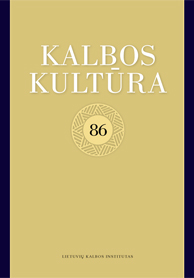Perkurtos frazeologijos žaismas žiniasklaidoje
Play on Recreated Phraseology in the Media
Author(s): Regina KoženiauskienėSubject(s): Syntax, Baltic Languages
Published by: Lietuvių Kalbos Institutas
Keywords: recreated phraseology; syntactic destructive figures; accumulation; hyperbaton; parcellation; parenthesis;
Summary/Abstract: The recreation of phraseology in the media relies on both the change of conventional and well-established lexis as well as syntactic order. First of all, phraseology itself is figure-based; stylistically, the figures around it are none the less important. The article shows how syntactic destructive figures help to highlight the meaning, implication and reasons of recreation of phraseology.As a result of the playful combination of recreated phraseology and destructive figures in the text, rhetorical functions of attraction of attention, intriguing, satire based irony and parody become especially strong. In combination with phraseology, destructive figures, which simultaneously comment on it, help to explain and understand the recreation of traditional phraseology and to highlight the turn of thought. The effect of the figures themselves increases when they intertwine among themselves, support one another and go together with phraseology.It has been proven that irrespective of the place of phraseology in the syntactic structure, it first of all combines with parcellation and other accompanying destructive figures – hyperbaton, accumulation, parenthesis, adjunction, ellipsis. The domination of parcellation and other destructive figures is seen in a number of publicistic texts of the journalism of evaluative type of recent years.The phraseology of the beginning, centre and end can be distinguished by the place of the paragraph content structure in which the rephrased text is located. The wittily recreated phraseology positioned in the beginning immediately draws the addressee’s attention and makes an unexpected intriguing impression. Central phraseology, framed by destructive figures, becomes the culmination of the paragraph. The phraseology positioned at the end creates an impression of a strong logical highlight and a vividly formulated final conclusion.The growth in the number of recreated phrases conflicting with conventional phraseology and the accompanying destructive figures can be associated with the confusion in social, economic, political and cultural life as well as the increased competition within the media.Critically and ironically-minded authors with a negative and especially hyperbolic evaluation of topical life affairs, witty and ingenuous parody as well as brave destruction of the old try to attract the addressee and to grip his/her attention by any means possible.
Journal: Bendrinė kalba (iki 2014 metų – Kalbos kultūra)
- Issue Year: 2013
- Issue No: 86
- Page Range: 149-166
- Page Count: 18
- Language: Lithuanian

